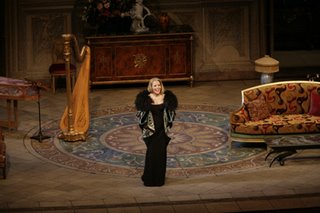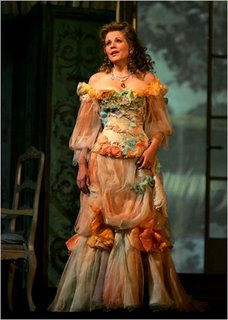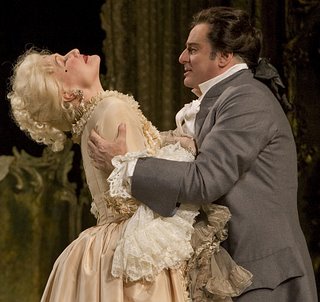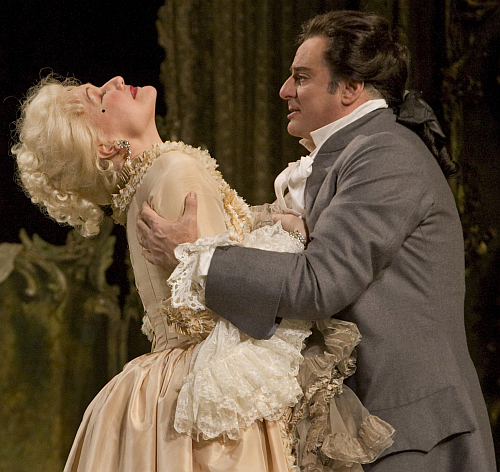 Simulcast
Simulcast du Metropolitan Opera House de New York
Samedi 16 février 2008, 13 h 00
Distribution : Karita Mattila (Manon Lescaut), Marcello Giordani (chevalier des Grieux), Sean Panikkar (Edmondo), Dwayne Croft (Lescaut), Dale Travis (Geronte), Paul Phlishka (l’aubergiste), Tamara Mumford (une musicienne), Bernard Fitch (un maître de danse), un allumeur de lampadaires (Tony Stevenson)
Chœurs et orchestre du Metropolitan Opera House de New York dirigés par James Levine
Costumes et décors : Desmond Heeley.
Mise en scène : Gina Lapinski.
Production originellement (1980) conçue et mise en scène par Gian Carlo Menotti
***
La production de Manon Lescaut de Puccini que l’on a pu voir lors du simulcast de samedi est virtuellement la même (décors, costumes, mise en scène) que celle, signée Gian Carlo Menotti, dont témoignait, il y a déjà près de trente ans, une représentation de l’œuvre mettant en vedette Renata Scotto et Placido Domingo qui est disponible en DVD sous étiquette Deutsche Grammophon (00440 073 4241). Tout au plus a-t-on rafraîchi quelques éléments de décor. L’ensemble est d’un réalisme efficace dont il n’y a pas lieu de se plaindre, sauf peut-être au dernier acte, excessivement sombre et dépouillé, où l’on a raté une occasion de nous montrer un coin de ces fameux « déserts de la Lousiane », qui n’existent que dans cet opéra.
Le principal atout que les deux enregistrements ont en commun est la présence, au pupitre, de James Levine, qui n’a jamais caché son admiration pour l’œuvre et son impatience de la faire mieux connaître. Il est instructif de constater à quel point tant sa conception de la partition que sa maîtrise de son métier ont évolué sur trois décennies. En 1980, sa direction, certainement, était plus fougueuse, plus passionnée, mais aussi moins subtile. Aujourd’hui il s’attache davantage aux détails qu’il distingue soigneusement de la masse orchestrale avec un doigté qui est devenu comme une seconde nature. Trop de doigté peut-être. Son deuxième acte, en tout cas, a déçu, de même que l’intermezzo qui précède l’acte suivant. Se pourrait-il que la partition, trop souvent dirigée, trop familière, commence à l’ennuyer?
Par contre, on se félicitera du fait que, cette fois-ci, le maestro ait accordé davantage de soin à la distribution des rôles secondaires, notamment à celui, assez ample, d’Edmondo, au premier acte. Le prestataire du rôle en 1980, et dont on taira le nom par charité, était à peine audible. Son successeur de 2008, Sean Panikkar, sans être transcendant, est de loin supérieur, et pourrait être promis à un bel avenir de ténor lyrique. Ont également droit à des médailles l’allumeur de lampadaires, Tony Stevenson, qui a fait bien davantage impression que son prédécesseur de 1980, et le maître de danse, Bernard Fitch, qui a su conférer un relief inhabituel à son emploi de comprimario en le dotant d’une parodie d’accent français très réussie.
Dwayne Croft (Lescaut) et Dale Travis (Geronte) sont de vieux routiers qui savent comment se glisser dans la peau d’un personnage pour ensuite l’ajuster à leur façon. Croft, très en voix cet après-midi, était le parfait roué, aussi méprisable que séduisant. Travis n’était peut-être pas en aussi bonne forme, mais cela ne l’a pas empêché de tirer tous les effets voulus des bouffonneries de son personnage.
Venons-en aux deux principaux chanteurs...
On se demande quel diablotin a pu suggérer à Mme Mattila l’idée de chanter la Manon de Puccini, rôle auquel rien, semble-t-il, ne la destinait. Non seulement a-t-elle le faciès d’une Gretchen plutôt que d’une Manon, mais elle a aussi l’âge de la sœur aînée de la mère de son personnage. Et pourtant, une fois sur scène, elle fait preuve d’une telle sincérité, d’une telle intensité, d’un tel talent de comédienne qu’elle réussit presque à triompher de ces obstacles, ainsi que de quelques gros plans peu charitables. Là où elle y parvient peut-être un peu moins, c’est au deuxième acte, où certains de ses efforts pour incarner une petite écervelée tombent carrément dans la niaiserie. Par contre, au dernier acte, où le facteur âge ne compte plus vraiment, elle emporte la conviction et, faisant appel aux ressources qu’elle a appris à faire fructifier au contact de Wagner, Janáček et Strauss, du coup transforme ce qui, trop souvent, n’est qu’un épilogue plus ou moins ennuyeux en un minidrame passionnant et quasi autonome, une sorte d’Erwartung vériste. À ce moment, et rien qu’à ce moment-là, je la préfère (oserai-je l’avouer ?) même à Renata Scotto, la Manon de 1980, pourtant une puccinienne consommée, ce que Karita Mattila n’est pas et ne sera jamais.
Mais qu’à cela ne tienne. Il y a des paris, même condamnés d’avance, qu’il vaut la peine de tenir au vu de certains des résultats. C’est le cas de la Manon de Mattila.
Marcello Giordani (des Grieux) est un artiste d’une grande intelligence et parfaitement au fait des difficultés de son rôle. Ce dernier est assez lourd, techniquement difficile et quelque peu composite, comme c’est souvent le cas dans les premiers essais de composition d’un futur grand maître. Non seulement le chanteur est-il, comme Manon d’ailleurs, confronté à des masses orchestrales qui, par moments, menacent de l’engloutir, mais le style vocal de ce qu’on lui demande de chanter tend à varier d’un acte à l’autre. L’approche de Giordani, comme il s’en est lui-même franchement expliqué dans un entracte, consiste à faire fond sur sa formation de belcantiste pour ensuite s’investir pleinement dans les passages qui mettent en valeur sa voix de lirico spinto. Sans doute le chanteur, qui n’a pas les moyens d’un Pavarotti, se ménage-t-il un peu au début, en prévision des défis des actes subséquents, mais lorsque le moment vient de montrer de quoi il est capable, il se dépense sans compter. Il sait également faire preuve d’esprit chevaleresque, au point d’appuyer discrètement, avec puissance et retenue, sa prima donna chaque fois que celle-ci risque de s’exposer un peu trop, en particulier dans leurs scènes d’intimité du deuxième acte. Quant à sa conception du rôle, j’avouerai que je la préfère à celle de Domingo. Tandis que ce dernier concevait des Grieux comme un jeune possédé à peine plus responsable de ses actes que sa Manon, le des Grieux de Giordani sait parfaitement qu’il agit comme un imbécile, sauf qu’il est incapable de faire autrement.
-Pierre Marc Bellemare
Le prochain simulcast du Met aura lieu le 15 mars prochain. On présentera alors Peter Grimes de Benjamin Britten.
> Lire : Critique en anglais par Joseph So
Labels: Manon Lescaut, Metropolitan Opera, Puccini
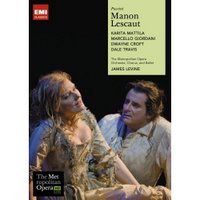 Karita Mattila, Marcello Giordani, Dwayne Croft, Dale Travis
Karita Mattila, Marcello Giordani, Dwayne Croft, Dale Travis
